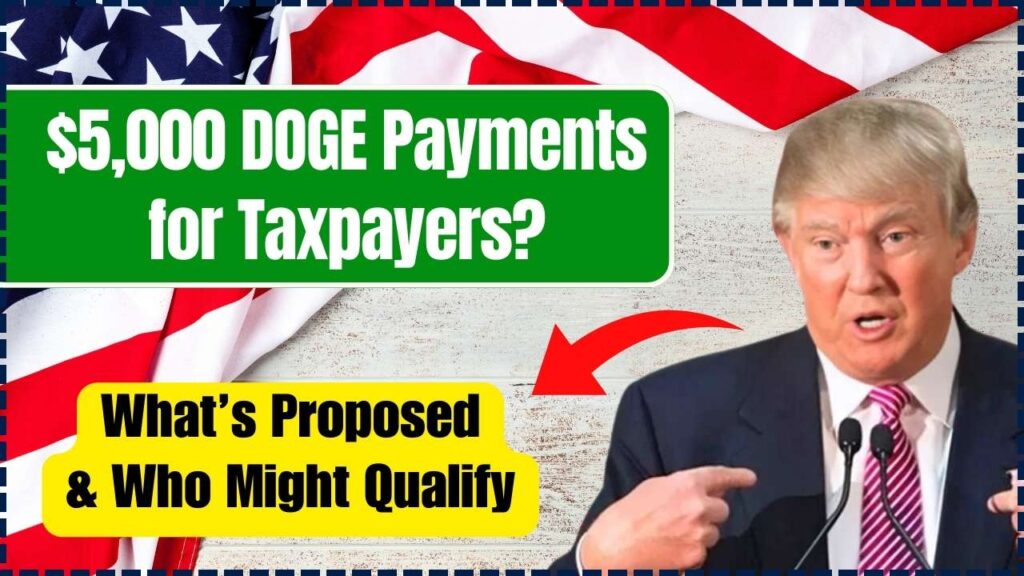$5,000 DOGE Payments for Taxpayers: If you’ve seen recent headlines about $5,000 DOGE payments for taxpayers, you might be wondering: Is this real? Who qualifies? And what exactly is the DOGE dividend? While it sounds like something pulled from internet memes, the idea is very real and is gaining traction in both political and financial circles.
The DOGE dividend proposal would send direct payments of up to $5,000 to qualifying U.S. taxpayers as a way to return a portion of federal government savings back to the people. These payments would be made possible through cost-cutting reforms initiated by a new federal body: the Department of Government Efficiency (DOGE). Here’s a detailed breakdown of what’s being proposed, who might benefit, and what to watch for in the coming months.

$5,000 DOGE Payments for Taxpayers
| Topic | Details |
|---|---|
| Proposed Payment | Up to $5,000 per qualifying taxpayer household |
| Source of Funds | 20% of cost savings generated by the Department of Government Efficiency (DOGE) |
| Eligibility | Net federal income taxpayers (those who pay more than they receive in credits/refunds) |
| Savings Target | $2 trillion in government efficiency savings |
| Projected Pool | $400 billion to be redistributed if target is met |
| Key Advocate | James Fishback, CEO of Azoria and public policy entrepreneur |
| Key Backer | Elon Musk, in collaboration with federal leadership |
| Official Info | Politico coverage |
The $5,000 DOGE dividend may sound too good to be true—but it’s part of a serious policy initiative aimed at rewarding taxpayers for government reform. While there are still many hurdles to overcome, the concept is gaining bipartisan interest and represents a potential new direction for how efficiency gains can be shared with the public.
Whether you’re curious about potential payments, interested in fiscal policy, or simply following government innovation trends, the DOGE dividend is a proposal worth watching. Stay informed through trusted sources, remain vigilant against misinformation, and consult with your tax advisor on how such a policy might affect your household if passed.
What Is the DOGE Dividend?
The Department of Government Efficiency (DOGE) was introduced in early 2024 with the aim of cutting wasteful government spending across federal agencies. It represents a unique public-private initiative, merging Silicon Valley innovation with Washington bureaucracy. Founded with backing from billionaire Elon Musk and other technology leaders, DOGE leverages artificial intelligence, data analytics, and administrative reform to enhance federal operations.
The DOGE dividend refers to a plan to return 20% of the department’s total savings to eligible taxpayers as direct cash payments. If the department achieves its ambitious goal of saving $2 trillion, this would allow a total payout of up to $400 billion, resulting in an average of $5,000 per household.
Who Would Qualify for the $5,000 DOGE Payment?
According to public comments from James Fishback, the DOGE dividend will be targeted at U.S. taxpayers who:
- Are classified as net federal income taxpayers, meaning they pay more in taxes than they receive in refundable credits
- Have filed federal tax returns for the relevant year
- Are U.S. citizens or legally residing residents
- Have no significant delinquencies or legal disputes with the IRS
This means the payment would likely exclude low-income individuals and households that rely heavily on refundable tax credits or owe no federal income taxes. The idea behind this targeting is to minimize inflationary pressures by focusing on taxpayers who are more likely to save than spend the funds immediately.
Fishback and other proponents argue that such targeting ensures the policy remains fiscally responsible while still rewarding the majority of working and middle-class families who contribute to federal revenues.
Why $5,000? Where Does That Number Come From?
The figure is based on a hypothetical distribution of 20% of $2 trillion in projected government savings. Here’s a simplified look at how the math plays out:
- DOGE Target Savings: $2,000,000,000,000
- Public Allocation (20%): $400,000,000,000
- Number of Eligible Households: ~80 million
- Average Payout: $400B ÷ 80M = $5,000
The actual amount could vary depending on:
- Final savings amount achieved by DOGE
- Congressional revisions to the distribution formula
- Number of households that qualify based on eligibility criteria
In essence, the $5,000 amount is a benchmark to illustrate the potential scale of the dividend, not a guaranteed payout.
Reference: Investopedia Explanation
How Would DOGE Reach the $2 Trillion Savings Goal?
DOGE is tasked with achieving its savings through a multi-pronged approach. The department has laid out a roadmap centered around:
1. Eliminating Redundant Agencies and Programs
A top priority is to consolidate overlapping federal programs. For instance, multiple departments offering similar grant programs may be merged or streamlined.
2. Automating Bureaucracy with AI
DOGE uses AI auditing systems to flag excessive spending and identify contract fraud, reducing the burden of manual reviews. Early estimates suggest these tools could save tens of billions in just a few years.
3. Modernizing Legacy Systems
Upgrading outdated government software and IT infrastructure—many of which date back to the 1990s—can improve efficiency and reduce operational costs.
4. Contract Negotiation Overhaul
DOGE aims to renegotiate old contracts, impose stricter bidding processes, and ensure vendors meet performance benchmarks.
So far, DOGE has reportedly saved $115 billion, which, while impressive, is still a fraction of the final goal. More aggressive reforms are expected in late 2025.
Benefits and Concerns: Balancing the Debate
Key Benefits:
- Incentivizes government efficiency by rewarding taxpayers
- Encourages transparency in federal budgeting
- Provides a significant financial boost to middle-income earners
- Could act as a model for future public-private savings initiatives
Key Concerns:
- High risk of falling short of savings target
- Political gridlock could delay or block legislation
- May trigger inflation if released during an overheated economy
- Criticized for excluding low-income, non-taxpaying citizens
Economists are split: Some believe it’s a smart, incentive-based policy, while others warn that injecting $400 billion could disrupt monetary policy goals, especially if savings are front-loaded into the economy.
DOGE Impact on Social Security? Employees Issue Urgent Warning!
Good News for Retirees Born Late in the Month: Up to $5,180 Coming Soon
Social Security Confirms April 3rd Payments for Some Disability Recipients – Up to $4,018
What Needs to Happen Next?
For the DOGE dividend to become reality, several milestones must be met:
- DOGE must prove its savings claims are legitimate and sustainable
- Legislation must be drafted and passed by both chambers of Congress
- The President must sign the bill into law
- The IRS and Treasury must create infrastructure for payment distribution
No formal legislation has yet been introduced, but conversations with lawmakers are reportedly “active and productive.” Given the complexity, it’s unlikely that anything will pass before late 2025 or early 2026.
What Taxpayers Can Do Now
Even if the DOGE dividend remains speculative, there are proactive steps taxpayers can take:
- Ensure tax returns are up to date
- Opt in for direct deposit to receive future federal payments faster
- Monitor legislation tracking platforms like Congress.gov
- Subscribe to updates from IRS.gov
- Avoid email or phone scams claiming early access to DOGE funds
FAQs On $5,000 DOGE Payments for Taxpayers
Q1: Is this related to Dogecoin or crypto?
No. The DOGE dividend is a government fiscal program, not a cryptocurrency or blockchain initiative.
Q2: How do I apply for the DOGE payment?
There is no application process at this time. Payments, if approved, will be automatically calculated and issued based on tax filings.
Q3: When would payments start?
If legislation passes in late 2025 or early 2026, payments could roll out in summer or fall of 2026.
Q4: Will it affect my taxes?
The current proposal involves no tax increases. It redirects savings from waste elimination, not new revenue.
Q5: Will everyone get $5,000?
No. Only households meeting eligibility rules would receive payments, and actual amounts may vary.
Timeline: What to Watch For
| Date | Event |
|---|---|
| Q1 2024 | DOGE department officially launched |
| Q3 2024 | First savings report released |
| Q1 2025 | Savings reach $115 billion |
| Q2 2025 | Proposal refinement and draft bill discussions |
| Q4 2025–Q1 2026 | Possible legislative action |
| Mid–Late 2026 | Estimated start of DOGE dividend distribution |










